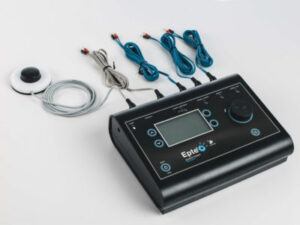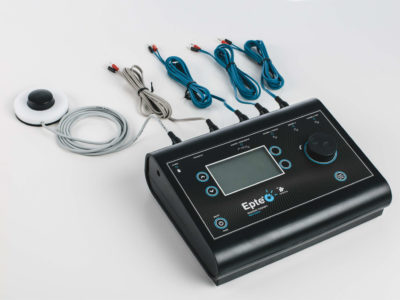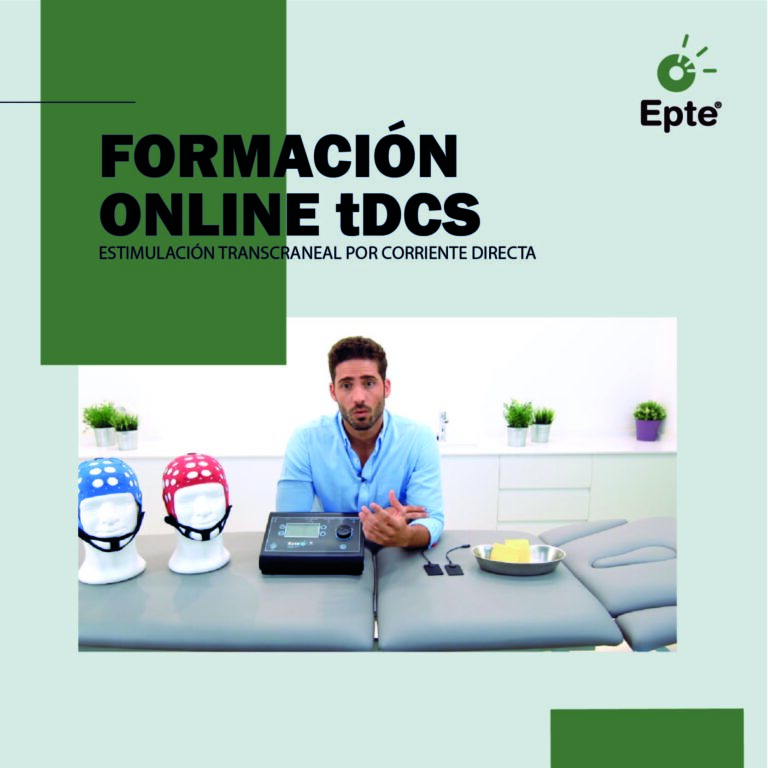Transcranial Direct Current Stimulation - tDCS
What is the tDCS transcranial direct current stimulation technique?
Transcranial electrical stimulation by direct current, or tDCS, is a non-invasive, painless brain neuromodulation technique that consists of the application of a low-intensity galvanic current to the patient’s scalp in order to electrically stimulate specific areas of the brain.
The application of the technique
The application of a tDCS treatment is quite simple. Electrodes are placed on a specific area of the skull, according to the cortical areas to be stimulated in each case. These electrodes will transmit a low-intensity current to the patient.
Different action protocols are put into place when applying the tDCS technique. Based strictly on scientific evidence and according to the type of pathology we must treat, we adapt the current flow we wish to administer and determine where on the patient’s skull the electrodes will be placed.
tDCS allows us to select the area of the brain that we wish to treat specifically; this, in turn, allows us to address pathologies across a number of different medical specialties.
Transcranial electrical stimulation is a revolutionary technique that is positioning non-invasive brain neuromodulation as the primary treatment before considering other more invasive treatments. It is the perfect therapeutic complement for patients with chronic ailments that are resistant to conventional treatments.
Effects of tDCS in patients
Treatment with tDCS generates a change in the membrane potential of cortical neurons, producing an increase or decrease in said membrane potential, depending on the anodic or cathodic effects of the electrodes.
- Anodic stimulation will produce increased cortical excitability.
- Cathodic stimulation will produce a decrease in cortical excitability (inhibition).
The transcranial stimulation technique is capable of generating neuronal plasticity in patients, which means that it allows neurons to regenerate, anatomically and functionally, and to form new synaptic connections.
Benefits of the tDCS technique
- Accelerated recovery times.
- Its has an analgesic effect and facilitates a reduction in the use of pharmaceuticals used to treat conditions such as fibromyalgia and chronic pain.
- The technique is painless, with almost no side effects.
- Because it is applied transcutaneously, tDCS is a non-invasive technique.
- Application of a transcranial stimulation treatment may be combined with other therapeutic techniques, helping them achieve better results.
- The patient does not require pre-treatment preparation.
Pathologies we can address
tDCS technique is now recognized to be a highly effective therapeutic tool for the treatment of pathologies pertaining to a range of medical fields.
The fields of application of this technique are:
- Chronic pain
- Fibromyalgia
- Migraines
- Motor rehabilitation following a stroke
- Parkinson's
- Depression
- Anxiety
- Addictions
- Attention deficit
COURSE
DATE
COURSE
SCHEDULE
PLACE
PRICE
A TECHNIQUE USED TO TREAT CHRONIC PAIN, FIBROMYALGIA, MIGRAINES, DEPRESSION, STROKE, ETC.
Transcranial direct current stimulation is a non-invasive brain neuromodulation technique, which consists of the application of a galvanic current in a determined area of the brain, using electrodes placed directly on the scalp.
PRODUCT

EPTE® Bipolar System
Currents and applications for the treatment of pathologies in the musculoskeletal system and the peripheral and central nervous system:
Percutaneous – Mono/Bipolar Needle | Transcutaneous
Galvanic (100µ to 10mA)
Galvanic (from 100µ to 10mA) + Microcurrents
Electrostimulation, Pointer or A, B and C
Electro-stimulation with MultiPulse system (SMP).
Transcutaneous:
Transcranial direct current (tDCS).
With this new equipment, we expand your possibilities.
Transcranial Direct Current Stimulation - tDCS
we offer products and courses to apply this technique
What is the tDCS transcranial direct current stimulation technique?
Transcranial electrical stimulation by direct current, or tDCS, is a non-invasive, painless brain neuromodulation technique that consists of the application of a low-intensity galvanic current to the patient’s scalp in order to electrically stimulate specific areas of the brain.
The application of the technique
The application of a tDCS treatment is quite simple. Electrodes are placed on a specific area of the skull, according to the cortical areas to be stimulated in each case. These electrodes will transmit a low-intensity current to the patient.
Different action protocols are put into place when applying the tDCS technique. Based strictly on scientific evidence and according to the type of pathology we must treat, we adapt the current flow we wish to administer and determine where on the patient’s skull the electrodes will be placed.
tDCS allows us to select the area of the brain that we wish to treat specifically; this, in turn, allows us to address pathologies across a number of different medical specialties.
Transcranial electrical stimulation is a revolutionary technique that is positioning non-invasive brain neuromodulation as the primary treatment before considering other more invasive treatments. It is the perfect therapeutic complement for patients with chronic ailments that are resistant to conventional treatments.
Effects of tDCS in patients
Treatment with tDCS generates a change in the membrane potential of cortical neurons, producing an increase or decrease in said membrane potential, depending on the anodic or cathodic effects of the electrodes.
- Anodic stimulation will produce increased cortical excitability.
- Cathodic stimulation will produce a decrease in cortical excitability (inhibition).
The transcranial stimulation technique is capable of generating neuronal plasticity in patients, which means that it allows neurons to regenerate, anatomically and functionally, and to form new synaptic connections.
Benefits of the tDCS technique
- Accelerated recovery times.
- Its has an analgesic effect and facilitates a reduction in the use of pharmaceuticals used to treat conditions such as fibromyalgia and chronic pain.
- The technique is painless, with almost no side effects.
- Because it is applied transcutaneously, tDCS is a non-invasive technique.
- Application of a transcranial stimulation treatment may be combined with other therapeutic techniques, helping them achieve better results.
- The patient does not require pre-treatment preparation.
Pathologies we can address
tDCS technique is now recognized to be a highly effective therapeutic tool for the treatment of pathologies pertaining to a range of medical fields.
The fields of application of this technique are:
- Chronic pain
- Fibromyalgia
- Migraines
- Motor rehabilitation following a stroke
- Parkinson's
- Depression
- Anxiety
- Addictions
- Attention deficit
Course
A TECHNIQUE USED TO TREAT CHRONIC PAIN, FIBROMYALGIA, MIGRAINES, DEPRESSION, STROKE, ETC.
Transcranial direct current stimulation is a non-invasive brain neuromodulation technique, which consists of the application of a galvanic current in a determined area of the brain, using electrodes placed directly on the scalp.
PRODUCT

EPTE® Bipolar System
Currents and applications for the treatment of pathologies in the musculoskeletal system and the peripheral and central nervous system:
Percutaneous – Mono/Bipolar Needle | Transcutaneous
Galvanic (100µ to 10mA)
Galvanic (from 100µ to 10mA) + Microcurrents
Electrostimulation, Pointer or A, B and C
Electro-stimulation with MultiPulse system (SMP).
Transcutaneous:
Transcranial direct current (tDCS).
With this new equipment, we expand your possibilities.


